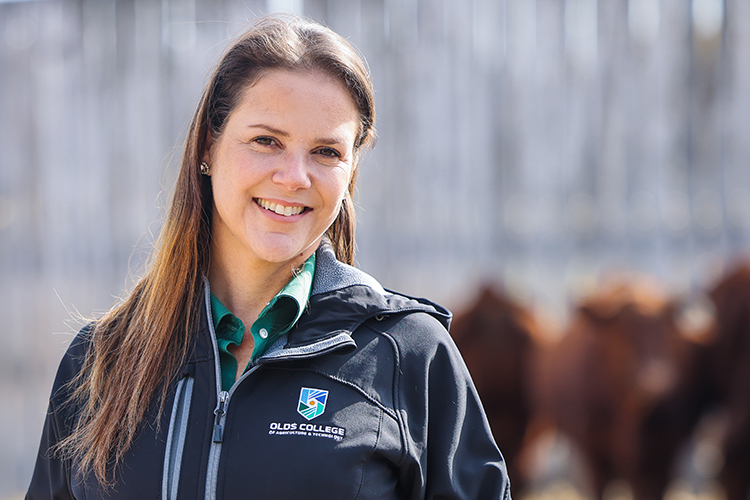Advancing Reproductive Efficiency & Stress Management in Beef Heifers

The primary goal of a cow-calf operation is to produce one calf per cow per year. However, the journey to achieving this reproductive success is fraught with challenges influenced by a variety of factors, including genetics, nutritional status, and stress, each playing a crucial role in the performance of heifers. Scientific literature highlights that more excitable heifers and cows tend to diminish their feed intake, adversely affecting their nutritional status. Additionally, excitable animals often have higher circulating concentrations of cortisol (a stress hormone). As the cortisol levels rise, so does the concern for the fertility of beef females.
A comprehensive two-year study was conducted by the Olds College Technology Access Centre for Livestock Production (TACLP) at Neilson Beef in Stettler, Alta., investigating reproductive efficiency and alleviating stress in beef heifers. The Neilsons provide custom feeding services to beef producers and are currently in their fourth year of providing a specialized heifer development service for the beef industry. Thus, the main goal of the research was to assess the effects of a cost-effective strategy, referred to as handling acclimation, on heifers' stress and pregnancy rates.
“Frequently, beef producers express concerns that handling animals more often will increase stress levels. Nonetheless, our research indicates that consistently and gently managing cattle can actually reduce stress and anxiety during routine procedures”, explains Dr. Désirée Gellatly, Research Scientist for the TACLP at Olds College.
Study Design
In the first year, 200 Angus crossbred heifers, aged 13-14 months were enrolled. Prior to breeding, heifers were assessed utilizing body condition scores and reproductive tract scoring and were subsequently divided into four equivalent groups. These groups were housed in distinct feedlot pens for approximately four weeks, with two groups assigned to each treatment — acclimation or control.
Briefly, prior to breeding and for five alternate days, a familiar handler entered the acclimated treatment pens. The handler adopted a soft-spoken approach while pail-feeding the heifers with a small amount of mixed barley. This method aimed to create, under animals’ perspective, a positive association of humans. Subsequently, these heifers were guided through the chute on three separate days receiving identical small feed rewards immediately after handling. Conversely, heifers in the control groups were solely fed by a feed truck and were not exposed to handling acclimation before breeding.
During the second year, a new group of 122 Angus crossbred heifers underwent an identical evaluation to the one conducted in the 2020 study, ensuring consistency in experimental procedures.
Assessment Metrics
In both years, heifers were randomly selected to be either exclusively exposed to bulls or subjected to artificial insemination before bull exposure. Salivary cortisol concentration was assessed at various intervals throughout the experimental period, concluding approximately 4 months after breeding, at pregnancy check day.
Key Findings
The outcomes on pregnancy rate for both treatment groups were independent of the breeding methods (natural or artificial insemination). Acclimated heifers exhibited a numerical rise of 2.23% in pregnancy rates compared to the control group in the initial year. In the second year, utilizing the new set of animals, this increase significantly escalated to 10.84%. Additionally, in the second year, the adoption of handling acclimation procedures elevated the likelihood of heifers becoming pregnant by 7.5 times.
Overall, heifers that underwent handling acclimation showed significantly lower cortisol concentrations as a result of a reduction in stress levels at handling compared to the control group.
Industry Benefits
After analyzing outcomes of the two-year study, the Neilsons have opted to permanently integrate handling acclimation protocols for all cattle raised at their operation, as well as for their customers' heifers. In the latest breeding season, Neilsons observed no instances of open heifers after receiving handling acclimation. Additionally, other producers, whose heifers experienced handling acclimation at Neilson’s operation within the last three years, also observed a 100% pregnancy rate. In terms of time commitment, there is a requirement to pail feed the animals and acclimate them to handling prior to breeding. However, the Neilsons indicated that a group of up to 100 heifers being handled only by him and his wife, Karyn Neilson, incurred 15 minutes of time per session to perform the acclimation. Further, they emphasized that the minimal time invested into acclimating their animals is well worth the results.
This article was adapted and republished with permission from Olds College of Agriculture & Technology.
Up next

uOttawa scientists develop novel radiotracer for earlier detection of disease
Turns out a spoonful of sugar helps the medicine go down - and lights up a PET scan.